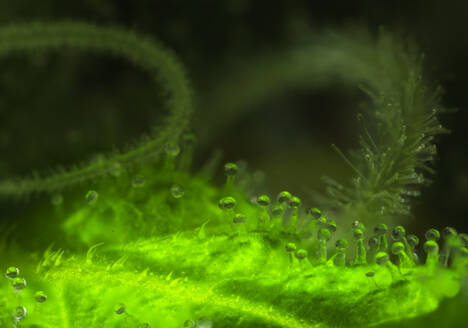The Zen-Effect of Marijuana
„When walking, walk. When eating, eat.“
Zen proverb
One of the most predominant effects of marijuana is a hyper focusing of attention during the high. Often, this hyper focusing is experienced together with intensified or increased sensations. While you are high, the taste experience of eating chocolate or drinking red wine usually becomes not only more intense but also more complex. You can selectively attend to many more dimensions within these experiences and better explore subtle nuances. We have many reports from experienced marijuana users observing this hyper focusing on all kinds of sensations, including auditory, visual, tactile, olfactory, taste or bodily sensations. In his seminal book “The Hasheesh Eater,” the American author and psychonaut Fitz Hugh Ludlow notes:
“(h)asheesh always brings with it an wakening of perception which magnifies the smallest sensation till it occupies immense boundaries.”
Another marijuana user describing the stronger focus of attention during a high expressed what he likes about marijuana as follows:
“I like all sorts of things about marijuana. (…) I like the first rush when time turns slow and liquid, and my hearing goes acute, and my focus intensifies. I like the way food tastes, the way country air smells, and the way water goes down my throat cool and clean. (…) I like the way a fine single malt scotch tastes when there is a nice coating of herb on my tongue, like velvet fire.”[1]
Hyper focusing during a Marijuana High
Generally, the hyper focusing of attention during a marijuana high leads to an intensification of sensory experiences and often to a better analytic capacity for introspectively exploring these states and processes. In addition, it can also lead to a pronounced focus on thoughts, feelings, moods, imaginations, or memories.
In his amazing article “The Effects of Marijuana on Consciousness”, psychology professor Arthur C. Hastings compared what I call a “hyperfocus” effect on attention with “psychological tunnel vision”:
“The process of attention is clearly affected by marijuana. The most obvious effect is to narrow the amount of diverse contents in the focus of attention. The person under marijuana usually perceives fewer objects of attention, which may mean physical objects, actions, social elements, emotions, etc. We have already noted this effect: a person who is high may become absorbed in an object, event, or process to the exclusion of everything else. A train of fantasy may occupy all of a person’s attention. This is a psychological analogy to tunnel vision, with the contents of the tunnel expanded.”[2]
Hyperfocusing and Zen Buddhism
With their minds unusually bound and absorbed by sensations, thoughts or fantasies, many users have noted that they have a strong feeling of being in the here-and-now – or, if focused on their memories intensely reliving a moment of the past, being in the “here-and-then”. They generally cease to share their attention between various tasks or stimuli – they do not eat a sandwich while talking to somebody on the phone and watching television. During a high, users tend to dwell in the immediacy of the moment, fully and joyfully appreciating whatever comes to their attention. Clearly, this is one of the teachings of Zen Buddhism: to focus on one activity and to appreciate the magical sensation of the moment, to be in the here-and-now. I therefore sometimes call the hyperfocusing effect of marijuana the “Zen-Effect”. Many marijuana lovers use this effect to enrich their lives. They use it to relax and be in the here-and-now when sitting on a dune watching the sunset, to deeply explore the experience of watching a waterfall or a painting of Edgar Degas, to better enjoy intensified tactile sensations during sex, or to simply concentrate on the way legendary double bass player Scott LaFaro unfolds his full potential with the Bill Evans Trio.
Use and Abuse of the Zen-Effect
The Zen-effect of marijuana holds amazing potential for recreation, especially for a modern society that demands us to constantly share our attention, jumping from telephone and mobile calls to writing emails, engaging in chat rooms, attending meetings, or reading notes on business network portals. Simultaneously, we are permanently distracted by advertisements lurking around every corner of our real and virtual existence. A marijuana high can be positively used to actually sit down and concentrate, to breathe, to be in the here and now, to come back to your senses, to intensely experience your own current bodily feelings, but also to concentrate on one’s memories, to enjoy a movie without distractions or to simply appreciate the fact that you are alive and well, sitting next to your beloved partner.
However, obviously, a marijuana high can be abused to constantly focus on the here and now in order to screen out problems in life. The adolescent marijuana abuser who permanently gets high to flee from problems with parents, teachers, and others is a commonly found example of abuse. Where marijuana can actually have a negative impact, that should not be underestimated. Sadly, prohibition has led to an enormous lack of objective education about marijuana, including the vital distinction between use and abuse. Many people deprived of this information had negative experiences with marijuana in their younger years and then refrained from marijuana completely and never explored the positive potential of the plant. A great number of these past abusers, therefore, remain skeptic regarding this potential.
The Zen effect is a good case to illustrate that the effects of marijuana can only be profitable if users learn and understand how to use the marijuana high and productively integrate it into their lives. Scientific investigations in the last few decades have almost exclusively been driven by a prohibitionist attitude based on misconceptions resulting from a long-term disinformation campaign against marijuana. Certainly, it is interesting to understand the risks of marijuana consumption, yet such studies were almost exclusively designed to show for which activities a marijuana high may not really be helpful, or even detrimental.
Re-focusing on the Potential of a Marijuana High
We as a society need to free ourselves from the old myths concerning cannabis, myths that have been installed by a decades-long disinformation campaign. This propaganda has locked our focus on risks – risks that have to a large degree been invented by spin doctors. We need to shift our attention. We have to start investigating the potential of marijuana – not only for industrial use or for various “physical” medical uses, but also the potential of the marijuana high – for inspirational, recreational, as well as psychological medical uses. Of course, we should not exclusively hyperfocus on the positive potential – we still want to know more about possible risks and therefore be able to educate the public about these risks – but it is now time to take a deeper look and explore the positive potential of the high as an altered state of consciousness. So far, prohibitionists are still making important decisions concerning the course of scientific research. They should be reminded of the words of the Chinese philosopher Lao Tsu in his famous book Tao Teh King, a dictum that holds true not only for the subject of marijuana:
“If something exists which cannot be fully revealed to him with his viewpoint, he does not demand of it that it be nothing but what it seems to him.”
[1] Cross, Mackkenzie (2010) “What I like about Marijuana”, in: Grinspoon, Lester (2014) (ed.), marijuana-uses.com
[2] Hastings, Arthur C. (1969) “The Effects of Marijuana on Consciousness.” In Charles Tart (1969/1990), Altered States of Consciousness, HarperCollins, San Francisco, Third Edition 1990, 407-32. Hasting’s incredibly insightful article is a must-read for anybody interested in the psychological marijuana high.


